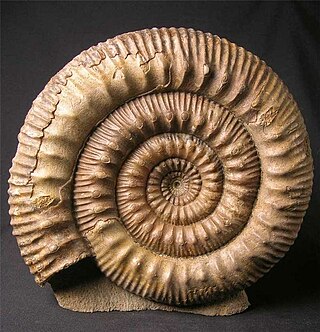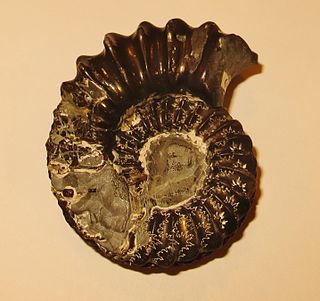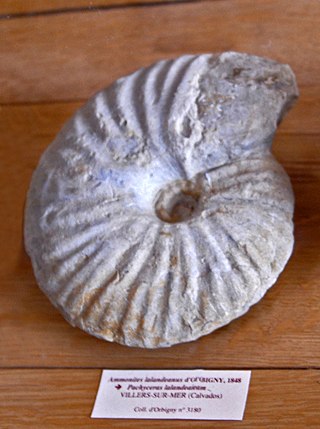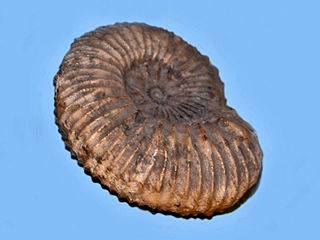In the geologic timescale, the Callovian is an age and stage in the Middle Jurassic, lasting between 165.3 ± 1.1 Ma and 161.5 ± 1.0 Ma. It is the last stage of the Middle Jurassic, following the Bathonian and preceding the Oxfordian.

Stephanoceras is an extinct genus of Stephanoceratoid ammonite which lived during the Bajocian. It is the type genus of the family Stephanoceratidae.
Abbasites is an extinct genus of ammonites from the early Middle Jurassic epoch, included in the ammonitid family Erycitidae.
Unipeltoceras is an extinct ammonite genus included in the perisphictacian family, Aspidoceratidae, and a member of the subfamily Peltoceratinae, that lived during the Callovian stage, late in the Middle Jurassic.

Simolestes is an extinct pliosaurid genus that lived in the Middle to Late Jurassic. The type specimen, NHMUK PV R 3319 is an almost complete but crushed skeleton diagnostic to Simolestes vorax, dating back to the Callovian of the Oxford Clay formation, England. The genus might also be known from the Tithonian Bhuj Formation of India (S.indicus), however the referral of this species to Simolestes is dubious. S.keileni from France was moved to the new genus Lorrainosaurus in 2023.

Cadomites is an extinct ammonite genus from the superfamily Stephanoceratoidea that lived during the Middle Jurassic.
Otoites is the type genus of the ammonite family Otoitidae that live during the Middle Jurassic.

Hibolithes is a genus of belemnite that lived from the Middle Jurassic to the Early Cretaceous, and has been found in Antarctica, Greenland, Iran, Europe, South America, and New Zealand. In 2020, this genus was found in the Pedawan Formation in Sarawak, on the island of Borneo (Malaysia).

Peltoceras is an extinct ammonite genus from the aspidoceratid subfamily Peltoceratinae that lived during the later part of the Middle Jurassic.
The Chari Formation is a Jurassic geologic formation in Gujarat, western India. Dinosaur remains are among the fossils that have been recovered from the formation, although none have yet been referred to a specific genus. The ammonite Reineckeia has also been found here. The skulls of two marine crocodiles have also been found and have been putatively identified as Steneosaurus.

Acanthoceratoidea, formerly Acanthocerataceae, is a superfamily of Upper Cretaceous ammonoid cephalopods belonging to the order Ammonitida, and comprising some 10 or so families.
Pachyceratidae is a family of Perisphinctoidean ammonites from the upper Middle - and lower Upper Jurassic. Genera within the Pachyceratidae have shells that are in general moderately involte but with most of the inner whorls exposed; whorl sections subquadrate to subtrapezoidal, with rounded venter. Ribbing is strong, in some sharp. Primary ribs typically branch above mid flanks into twos, threes, and even fours.

Kepplerites is a moderately evolute ammonite from the lower Callovian included in the Stephanoceratoidea.

Hecticoceras is an ammonite genus belonging to the haploceratoid family Oppeliidae, that lived during the Middle and Late Jurassic, from the Callovian. Hecticoceras may be seen as a series of some nine subgenera, beginning with the lower Callovian H. (Hecticoceras) and H. (Hecticoceratoides) and ending with the lower Oxfordian H. (Pseudobrightia) and H. (Eochetoceras). Hecticocerassensu lato and Prohecticoceras from the underlying Bathonian form the oppeliid subfamily, Hecticoceratinae.

Pachyceras is a genus of perisphinctoid ammonites from the Middle Jurassic, upper Callovian stage, and is the type genus for the family Pachyceratidae. The shell is involute, subglobular, with a deep umbilicus and flattened flanks that slope toward a more narrowly rounded venter, and covered by low, widely spaced ribs.

Kosmoceratidae is an extinct ammonite family from the Callovian to Early Cretaceous.

Cadoceras is an extinct ammonite genus belonging to the Cardioceratidae that lived during the Jurassic period from the late Bajocian to the early Callovian.

Hammatoceras is a genus of ammonites belonging to the family Hammatoceratidae which lived during the Toarcian stage of the Early/Lower Jurassic between about 184 and 175 million year ago.
The Ornatenton Formation is a Jurassic marine formation in Germany that is middle Callovian in age. The formation represents a shallow marine environment.
Funiferites is genus of ammonite that lived during end of middle and in upper Callovian stage of middle Jurassic.
















